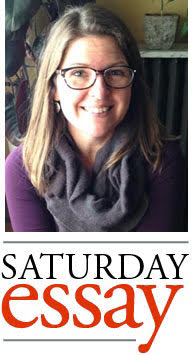Like many people, I didn’t start to drink coffee until college. Back then, as a newbie, I offset its bitter flavor with too much cream and sugar. I was also an “Equal” person for a while. But, having grown to love the taste of coffee, my cup today holds strongly brewed coffee with only a teaspoon of sugar and a splash of cream, half-and-half, soymilk, that powder stuff, whatever’s on hand. I’m not fussy. In the absence of any of that, I’ll drink a cup black now and then.
This is partly to say that I am not really a coffee snob, although I do engage in some haute coffee culture. For instance, I make my coffee each morning in a press. I enjoy a cup of Ethiopian cold-pressed coffee from specialty shops like Duluth Coffee Co. On the other hand, I sighed with delight over several cups of Folgers made in a drip machine on last year’s cabin-camping trip with my daughters’ Girl Scout troop.
On the other, other hand — and this only makes sense if you’re in the know about haute coffee culture — I have yet to try a cup of coffee with butter in it. Hipsters swear by it. I might go there; we’ll see.
Coffee also has plenty of politics surrounding it. You should buy shade-grown coffee from sustainable farms, but it is hard to distinguish where and how your coffee has been grown just by looking at labels of mainstream brands. You should buy coffee locally roasted and ground, but often smaller companies buy their stock from wholesalers who also don’t know where and how the coffee they buy is grown.
At work, my office has a single-serve coffee maker. Many colleagues feel this is environmentally unsound. True, the plastic packaging is excessive; the inventor of this type of coffee pod was reported to regret his design. Some people, therefore, use a reusable filter for the machine. Others buy coffee pods made with a paper filter, rather than a plastic cup.
These are all things a coffee drinker might mull over when making his or her own cup. A whole different problem arises, however, when a coffee drinker orders from across a counter. This problem is centered on cream. Specially, the amount of cream a coffee drinker does (and does not) want in his or her cup. More specifically, it is a problem of communicating this amount.
I mentioned I like a “splash” of milk or cream in my coffee. A splash is not much. It’s less than a little plastic creamer stacked on the table at a diner. It’s probably, like, half an ounce. Of course, I don’t expect other people to know my splash measurement. And I realize I can’t ask for a half an ounce of cream at the donut shop. I’m not crazy; I just love coffee.
Accordingly, I’ve tried to communicate my splash of cream in many ways. But, no matter what I say, I’m handed cup after cup of a drink that’s a light, lovely, creamy shade of pale beige. The same color as vanilla ice cream. The putty-color of khakis from the 1990s. A standard file folder. Tropical beach sand.
Consider these attempts:
At a museum coffee shop:
Me: “Hi, can I please have a small coffee with one sugar and just a tiny bit of cream?”
Received: Drink the color of vanilla ice cream.
At a coffee counter:
Me: “Hi, can I please have a small coffee, dark, with one sugar?”
Received: Putty khaki-colored drink.
Response: “Oh, I asked for it dark.”
Server: “It’s dark-roast.”
At a fast-food drive-through:
Me: “Hi, can I please have a small iced-coffee with one sugar and cream on the side?”
Received: Standard file folder plus five little diner-creamers in a bag.
At a fast-food counter:
Me: “Hi, can I please have a small coffee with one sugar and not much cream at all?” (Accompanied by a tentative, scrunched-up question-mark face and voice to match.)
Server, handing me the bottle: “Why don’t you do it?”
Yes. Let me do it. Many places leave the accouterment out for coffee drinkers to do it themselves. Often, though, as I have described, young servers who themselves do not drink coffee or are coffee newbies go heavy — so heavy — on the cream. Having grown into my coffee love, I understand their hesitation. Or perhaps it is an effort to make the coffee palatable for others. They are being thoughtful, not thoughtless, I am sure.
It’s not just me. My husband, who loves coffee less than me, but still enjoys a strong cup in the afternoon, has experienced similar cream communication issues. I will leave you with this final example, after which you might remember your own example. More likely, you will want to argue with me over the relative importance of coffee, cream, and communication. Go ahead. Only two are important to me.
Husband: “Hi, can I please have a small coffee with one sugar, light on the cream?”
Received: Drink the color of tropical beach sand.
Husband: “Oh, I asked for it light.”
Server: “Yes, it’s very light.”
